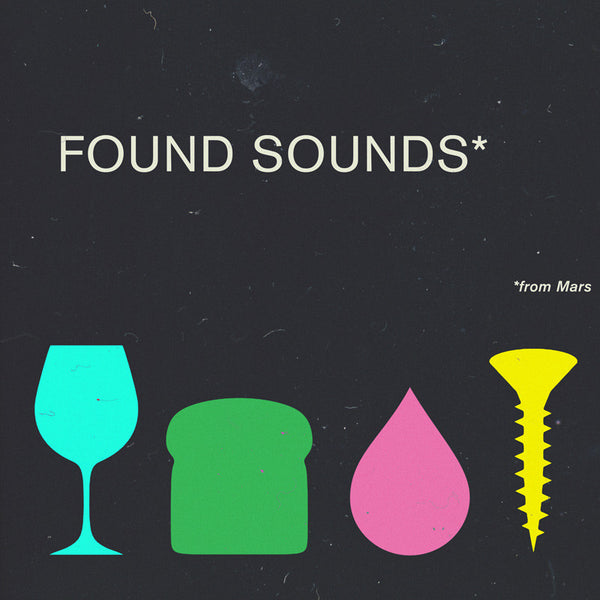FOUND SOUNDS FROM MARS
$29.00 $14.50
A Collection of Acoustic Field Recordings Re-Pitched on Tape & More
For this release, we had field recording experts Jonathan Hyde, Adam Newns & Simon Haines capture unique foley and acoustic sound FX in different natural environments (totaling over 16 minutes of audio), and then took the results back to SFM headquarters, where we tube saturated them, re-pitched them on tape, and morphed them through the crazy Lexicon Vortex.
We recorded percussive and ambient sounds in various natural environments - nature, on the street, indoors, in a studio - and with different materials - wood, glass, plastic, our body, etc. We recorded vocals, rain hitting various objects, thunder, traffic, the ocean, vinyl, elevators, refrigerators, drill bursts, pepper grinder, toaster, metal pots, coins, plastic bins, metal gates, tree chops, twig snaps, water droplets, PVC pipes and more. Our field recording setup was a Sennheiser 416, Sound Devices 302, into a Zoom H6. Using the excellent limiter on the Sound Devices allowed us to catch more of the releases on many of the impacts.

To capture sounds in stereo, we used the -20dB backup record function on the Zoom and blended the two recordings to get the same result. In some cases, eg. the glass smashes, we even blended the Zoom mics with the 416 to catch the impact. We also used contact and condenser mics for some of the more eccentric sounds such as the electric signal noise.
The sounds then underwent processing, including layering of different sounds together, stretching, re-pitching, cropping, compression, EQ and in some cases additional reverb/ambience.
Once we got the sounds just right, we tube saturated the whole bunch with our Culture Vulture, opting for a low bias setting which allowed us to open up the release, achieving warmth and loudness. We then recorded all of the hits to tape at 15 ips, and played them back at 7.5 ips and 30 ips, giving us a whole batch of new samples at lower and higher octaves.
Finally, we reached for our secret weapon - the little known but very cool Lexicon Vortex - originally designed as a morphing effect for guitarists back in the day. This thing is super cool for weird, resonant modulations, dynamic delays and general wild stereo imaging. Plus Daft Punk toured with one in the 90s.

The end result is a custom collection of percussive and ambient foley, repurposed for modern music making, and especially cool for layering with more traditional drum samples.
What You Get:
- 650+ 24bit WAV Foley / Field Recording Samples
- Adds up to Over 1 hour of Field Recordings
- Clean, Tube Saturated, re-pitched Tape, and Vortex Samples
- Ableton Live 9 Session containing 15 fully mapped drum racks
- 15 Kontakt, Logic & FL Studio Instruments
- WAV Samples organized by folder
- Requirements: Ableton Live 9.7+ (Not Intro), Kontakt 4+ (Not Player), Logic 9+, FL Studio 20.8+
- 1.25 GB Unzipped
What You Get:
- 650+ 24bit WAV Foley / Field Recording Samples
- Adds up to Over 1 hour of Field Recordings
- Clean, Tube Saturated, re-pitched Tape, and Vortex Samples
- Ableton Live 9 Session containing 15 fully mapped drum racks
- 15 Kontakt, Logic & FL Studio Instruments
- WAV Samples organized by folder
- Requirements: Ableton Live 9.7+ (Not Intro), Kontakt 4+ (Not Player), Logic 9+, FL Studio 20.8+
- 1.25 GB Unzipped










